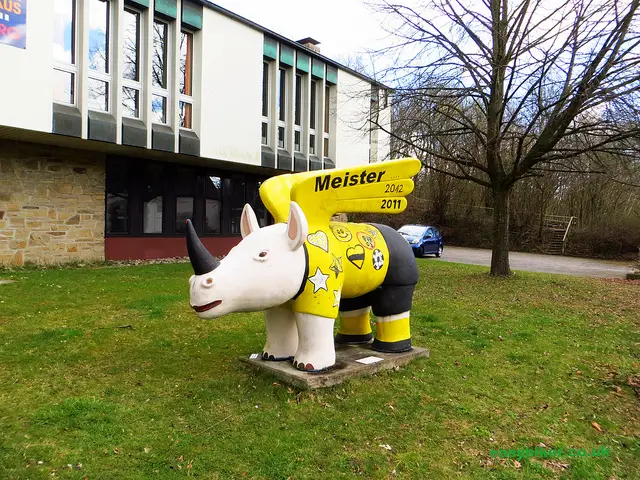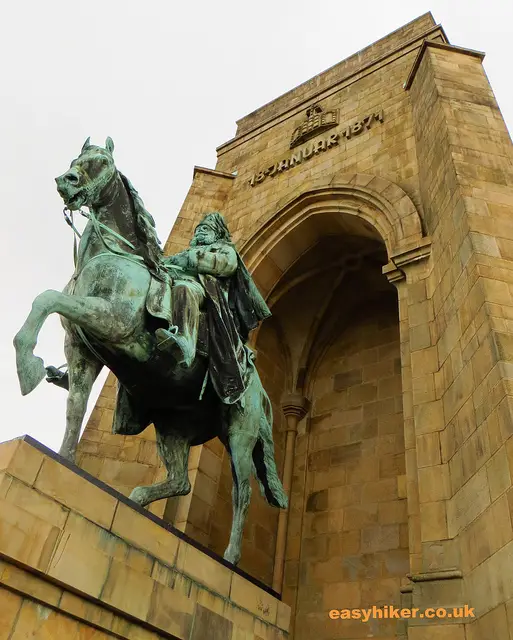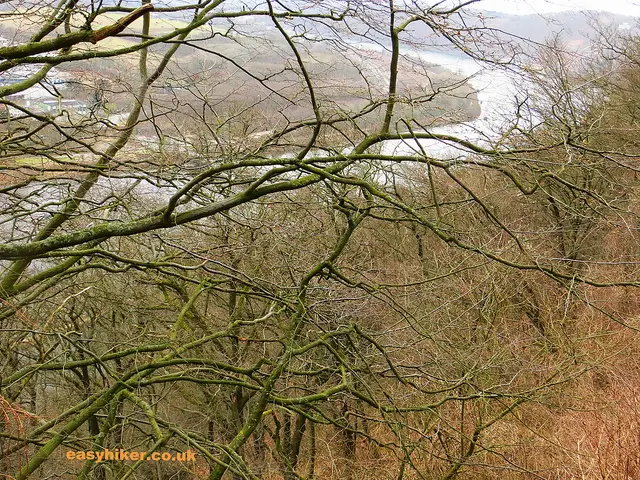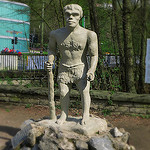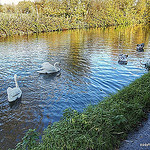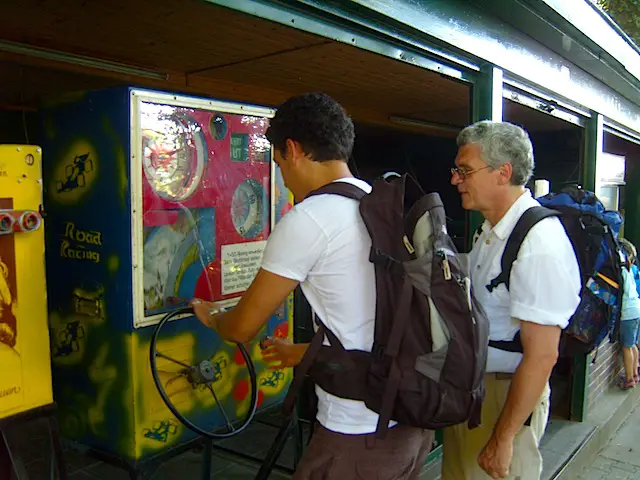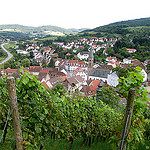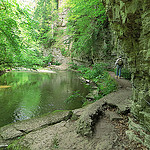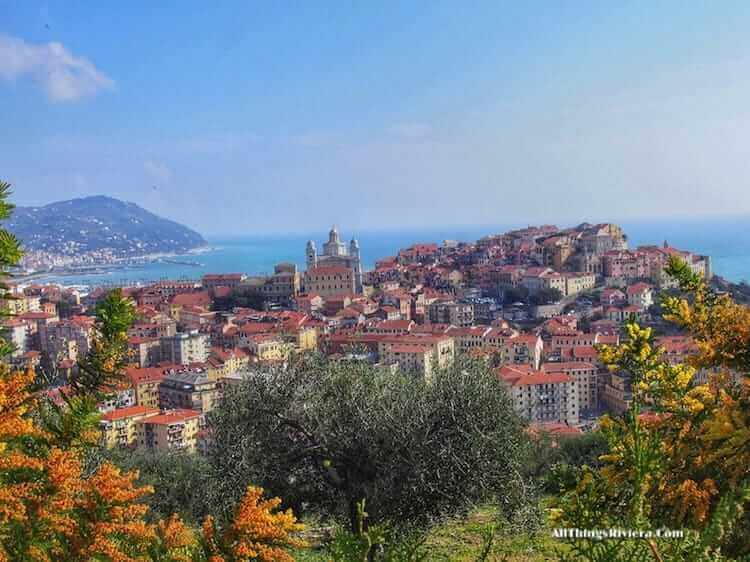Where to Go in Germany
Daytrip Destination: Syburg
I had seen the Syburg (not knowing at the time what it was called) many times from the train and on various hikes in the area, always wondering how its disparate elements – the monument with the equestrian statue, the medieval ruins – were connected. It simply did not seem to make much sense.
I had seen it so many times, in fact, that I immediately recognized it when we arrived to sample one of West Germany’s favourite daytrip destinations, located at the southern rim of the city of Dortmund, on the edge of a large expanse of parks and woodlands.
I was also able to solve the mystery of the connection between the castle ruins and the monument: there is none, apart from the fact that the builders of either – tribal chieftains in 700 AD. The architects of the Kaiser Wilhelm Memorial – both liked the location high above the Ruhr valley, one suspects, for exactly the same reasons.
For a place that is such a favourite with people from the near-by cities on the Ruhr, the Syburg is amazingly hard to reach by public transport. For all practical purposes, there is only one bus line, the 432, and only one such bus per hour through the day.
If you come to this daytrip destination by train, you can catch the 432 from the station of Dortmund-Hörde where you have a 40 minute wait. Alternatively, you can go to Schwerte station, but there – bear with me – you have to take another bus (the C31) to a place called Holzen where the two bus lines meet.
The catch with this connection is that you have a wait of exactly 0 minutes between the arrival of the two buses, so the connection must function like clockwork, otherwise you have to wait (nearly) 60 minutes to continue your journey.
We decided to risk it, full of confidence in the German ability to precision-engineer their bus schedules as well as their fancy cars – with the result that we were stranded for a full hour in Holzen, which is not really a town or a village at all…
… but an industrial park.
There was not even a place where we could have sat down for a cup of coffee, so in our despair, we took a walk around the estate, all boots and backpacks and ready for our hike.
The workers who were loading and unloading large pallets for the warehouses along our way must have been thinking that we were a very strange couple indeed. (They were probably right.)
Leave the 432 bus at the final stop (Syburg) and turn left to walk uphill. This is a very peaceful and leafy area, not at all like the (post-) industrial Ruhrgebiet that surrounds it on all sides.
Which is probably why they chose this spot to build the Ruhrgebiet’s first casino, a gleaming glass structure that you will encounter after a few hundred meters or so. (There is no fixed dress code for the slot machines, but if you fancy a game of roulette, hiking gear is perhaps not the most suitable attire.)
There is quite a lot else to see on the hill: one of west Germany’s oldest churches, for example, St Peter of Syburg, built by Charlemagne on the site of a former pagan temple and consecrated by Pope Leo III.
The original church, made of wood, has long disappeared, but even the “new” stone building is almost a thousand years old, and a couple of gravestones on the cemetery date indeed from the 8th century AD.
Further uphill, on your left hand side, you come across the ruins of the Sigiburg.
The original castle – of which some remnants are still left – was conquered by Charlemagne in his defeat of the local tribes and then used as a fortress from where to Christianize the entire area.
Most of what you see today in this daytrip destination stems from the 12th century when the castle grounds covered most of the land on the hilltop, probably reaching as far as the casino and beyond. (The war memorial was added in the 1930s, the belvedere tower in 1857.)
On the other side of the hill, a few steps away, you will find the Kaiser Wilhelm Monument – no, not that Kaiser Wilhelm, the infamous Kaiser Bill with the steely eyes and the corkscrew moustache, but his grandfather, Wilhelm I, the first Emperor of the new Reich (1871-1888).
Oops – wrong picture, sorry. Got that all mixed up with the ones we took earlier at Holzen industrial park. Here is the correct one:
The monument was built in 1902 to commemorate the foundation of the Empire and reworked in the 1930s (under the Nazis) when the original architecture, a rather frilly Victorian concoction not unlike London’s Albert Memorial, was apparently deemed insufficiently heroic.
The statues of General Moltke and Bismarck, formerly standing side by side with the Emperor, were also sidelined and relegated to domed niches.
Articles about the Syburg generally make much of the “splendid” views. Well, it is certainly true that you can see a long way into the Ruhr valley and beyond.
A “panorama panel” puts names to the various elements of your view – just like in Montmartre underneath the Sacre Coeur, for example, where they tell you in what direction to look for the Louvre and identify small, distant towers as the Notre Dame or the Sainte Chapelle. Here, the panel does the same for sewage plants and a waste incineration facility. (Just to remind you that this IS the Ruhrgebiet, after all.)
Once you have digested the view, you are ready to descend to Lake Hengstey and the river Ruhr. There are two paths leading down, one that sweeps on your right hand side through the forest, and one directly from the viewing platform, zigzagging all the way down.
On the day we visited the Syburg, however, both of these paths were closed off and blocked – for our own safety, as the notice on the barrier informed us, to protect us from some mortal dangers that were apparently lurking along the way.
So the view from the top down on Lake Hengstey …
… would be as close as we got. Our original plan had been to turn left and to walk along the river Ruhr for a kilometre or so before turning back into the forest and returning uphill in a sweeping curve to the Syburg Memorial. (There are two such “loops” that you can do, one app. 5 km long and the other app. 12 km.)
For us, all that was left was to beat our way back to the bus stop – in the realization that our walk around the Holzen industrial park had been all the hiking we would get for the day.
We let our frustration off over two enormous American-portion-sized Grilltellers at the Haus Syburg restaurant (open throughout the day) before taking the bus to Dortmund where we topped it all off with a round of ice cream in the city centre. (I never promised you that you would lose weight by following us on our hikes.)
As it happens, this turned out to be the kind of hike that Mrs. Easy Hiker enjoys most. It must have been her lucky day. Perhaps I should have taken her to the casino, after all.







